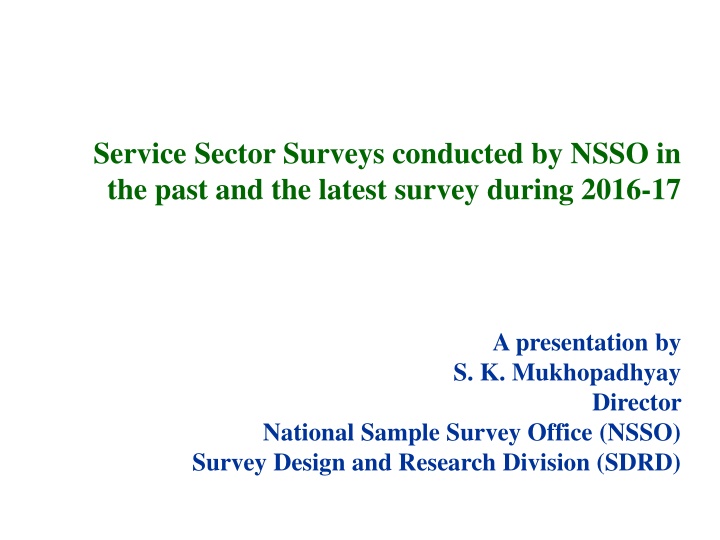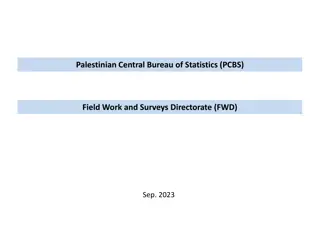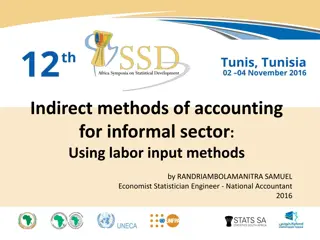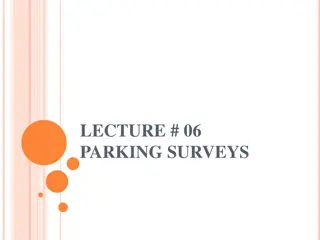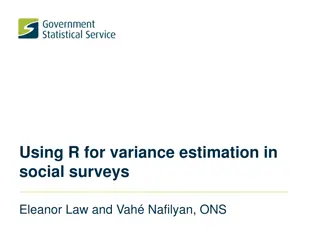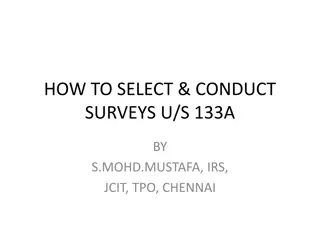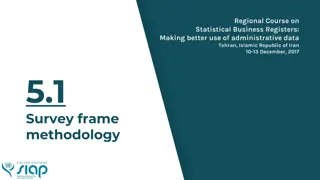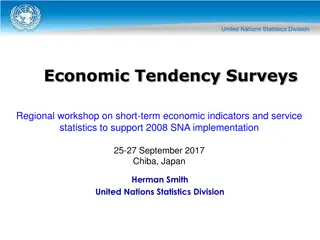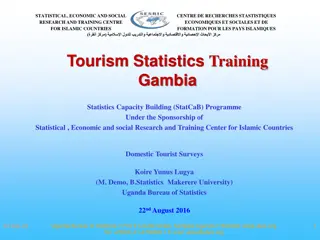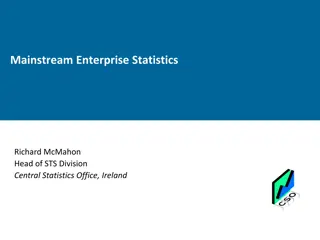Evolution of NSSO Surveys in Service Sector
The presentation discusses the evolution of NSSO surveys in the service sector, focusing on phases before and after 1977. It covers the importance of the service sector in India, survey methodologies, and key findings regarding workforce and economic activities. The content delves into the significance of Economic Census, sample designs, and the transition towards more detailed and comprehensive data collection methods over the years.
Download Presentation

Please find below an Image/Link to download the presentation.
The content on the website is provided AS IS for your information and personal use only. It may not be sold, licensed, or shared on other websites without obtaining consent from the author.If you encounter any issues during the download, it is possible that the publisher has removed the file from their server.
You are allowed to download the files provided on this website for personal or commercial use, subject to the condition that they are used lawfully. All files are the property of their respective owners.
The content on the website is provided AS IS for your information and personal use only. It may not be sold, licensed, or shared on other websites without obtaining consent from the author.
E N D
Presentation Transcript
Service Sector Surveys conducted by NSSO in the past and the latest survey during 2016-17 A presentation by S. K. Mukhopadhyay Director National Sample Survey Office (NSSO) Survey Design and Research Division (SDRD)
Importance of Service Sector in India Percentage share of service sector in GDP at factor cost 70.0 60.0 percentage share 50.0 40.0 30.0 20.0 10.0 Service Sector encompasses a diverse domain of economic activities, sizes and operational characteristics of units. Out of 21 sections of ISIC, service sector has 13 sections 27% of workforce (as per NSS survey on Employment and Unemployment conducted during 2011-12) 44 million unincorporated non-agricultural enterprises and 75 million workers in these enterprises (73rd round: 2015-16) 0.0 1958-59 1961-62 1964-65 1967-68 1970-71 1973-74 1976-77 1979-80 1982-83 1985-86 1988-89 1991-92 1994-95 1997-98 2000-01 2003-04 2006-07 2009-10 2012-13
NSS surveys on Service Sector: Phases of evolution NSS surveys on services sector can be split in three different phases: Economic Census (EC) is the complete count of all establishments (i.e. units engaged in production and/ or distribution of goods and services not for the purpose of sole consumption). Phase I: Prior to 1977: Household based non-agricultural activities To provide: Phase II: 1977 to 2007: Follow-up surveys covering household and non-household enterprises of Economic Census of establishments and number of workers by industry, by type of ownership of the establishments, etc. at the village/block level, an up to date areaframe containing information on number Phase III: After 2007 present phase: (i) Unincorporated enterprises, (ii) Survey of Services Sector from which sample villages/blocks could be drawn as the primary sampling units for collecting detailed information about the establishments in the follow-up sample surveys..
NSS surveys on Service Sector: Phases of evolution: Prior to 1977 1st round of NSSO (July, 1949 to June, 1950): Covered cottage industries, crafts and any trade, business. Integrated surveys during 1964 to 1970: Covering (i) household enterprise, (ii) consumption and (iii) capital formation and saving. Consider 29th round of NSS: 1974-75 Coverage: Small Scale Manufacture and Repair Services (Non-registered), Transport, Restaurants, Services and Construction, Mining And Quarrying Trade, Hotels And
NSS surveys on Service Sector: Phases of evolution: Prior to 1977 Selection of First Stage Units: Probability proportional to size (a measure of population) Selection of Households: linear systematic sampling Sample Size: 13384 FSU, 240,000 households (12 enterprise per FSU in rural areas and 28 to 30 enterprise per FSU in urban area) Sample design: Stratified two-stage : first-stage units were 1971 census villages areas and urban blocks in urban areas. The second stage units are households for the socio-economic enquiries. in rural
NSS surveys on Service Sector: Phases of evolution: Prior to 1977 Drawback of the surveys during phase I: The household approach of identifying the units excluded the non-household based units:cooperative societies, trusts, SHGs, etc. Information on areas with a concentration of enterprises was not available. This was felt necessary for ensuring an efficient sampling for the future surveys.
NSS surveys on Service Sector: Phases of evolution (1977 to 2007) A series of Economic Censuses were conducted by NSSO as follows: In 1977, the first Economic Census In 1980, second Economic Census In 1990, third Economic Census In 1998, fourth Economic Census In 2005, fifth Economic Census In 2013-14, sixth Economic Census
Follow-up Surveys on Economic Census Since the first Economic Census (EC) conducted in 1977, NSSO has been conducting follow-up surveys of ECs on periodic basis. So far there are 14 follow up surveys on non-agricultural enterprises were conducted. The first was the survey on Unorganised Manufacture-Non Directory Establishments and Own Account Enterprises conducted during 33rd Round (1978-79) and the latest on Unincorporated Non-Agricultural Enterprises (excluding Construction) conducted during NSS 73rd Round (2015-16). These Surveys covered different sectors of unorganised/ unincorporated non-agricultural Manufacturing, Trade and other Services. enterprises such as
NSS surveys on Service Sector EC NSS Round Follow up survey of EC small establishments and OAEs engaged in manufacturing and repair activities integrated survey on trade, transport, hotel and restaurants and services 2 40 OAEs and NDEs engaged in manufacturing and repair activities * 2 41 OAEs and NDEs engaged in trading activities* 2 45 OAEs and NDEs engaged in manufacturing and repair activities * 2 46 OAEs and NDEs engaged in trading activities* 3 51 Unorganised manufacturing Directory establishments and OAEs 3 53 Unorganised Trade: OAEs and non-directory establishments* - 55 Informal non-agricultural enterprises 1 33 1 34
NSS surveys on Service Sector NSS Round 56 57 62 63 EC 4 4 4 4 Follow up survey of EC unorganised manufacturing unorganised services (excluding Trade and Finance) manufacturing enterprises service sector enterprises (excluding Trade) Unincorporated non-agricultural enterprises (excluding construction) Unincorporated non-agricultural enterprises (excluding construction) 5 67 6 73
NSS surveys on Service Sector: Phases of evolution (1977 to 2007) Objective: To estimates economic and operational characteristics. Economic characteristics: average no. of workers, fixed assets, outstanding loans, total receipts, total operating expenses and gross value added. Operational characteristics: ownership, nature of operation, location, status of registration, etc. Use: These economic and operational indicators are required for planning, policy and decision making at various levels, both within the government and outside.
NSS surveys on Service Sector: Phases of evolution (1977 to 2007) Informal sector enterprises in NSS 55th round during 1999 to 2000 All non-agricultural enterprises with type of ownership as either proprietary and partnership . The survey covered all informal non-agricultural enterprises other than those covered under (i) mining & quarrying , (ii) electricity, gas & water supply , (iii) Public Administration and Defence; Compulsory Social Security , (iv) Private Households with Employed Persons , (v) Extra Territorial Organizations and Bodies . 28 million enterprises in service sector employing 47 million workers
NSS surveys on Service Sector: Phases of evolution (1977 to 2007) The 57th round (2001-02) covered broadly all unorganised service sector enterprises engaged in the activities hotels communication; real estate, renting and business activities ; education; health and social work; and other community, social and personal service activities (excluding trade and finance). and restaurants; transport, storage and Important Estimates: 14 million enterprises employing 27 million workers
NSS surveys on Service Sector: Phases of evolution (1977 to 2007) The 63rd round (2006-07): FEATURES Two frames : List frame and Area frame. A list of about 1000 service sector companies was used as list frame. Out of these 438 were surveyed. Area frame covered 14000 FSUs surveying 189,844 units. indicator Surveyed enterprises Estimated workers (in million) % share of workers % share of GVA List frame 438 0.6 2% 38% Area frame 189844 33 98% 62%
Fine tuning made in design of the survey Allocation of First Stage Units: Total FSUs to be surveyed were allocated to the rural and urban areas in proportion to the number of workers in service sector enterprises as per EC (for example in 63rd round according to EC '98) engaged in the activities under coverage of the survey. Formation of sub-stratification using information on number of hired worker in different types of services sector enterprises Selection of FSUs for better representation: FSUs were selected generally using PPS with size as workers.
Fine tuning made in design of the survey Widening the coverage by inclusion of different types of service sector enterprises. Special effort to capture bigger service sector enterprises Formation of special stratum one each for Rural and Urban sector at the State level consisting of all the FSUs of the State / UT having at least one big unit or having a large number of workers engaged in the same activity. Introduction of List Frame to supplement the Area Frame: during 2006-07
NSS surveys on Service Sector: Present phase (after 2007) Two surveys during 2010-11 (67th round) and 2015-16 (73rd round) Unincorporated non-agricultural enterprises in manufacturing, trade and other service sector (excluding construction) Coverage is of the entire unincorporated part of the economy (except construction) Proprietary and partnership enterprises, Trusts, Self-help groups (SHGs), Non-Profit Institutions (NPIs), etc. Sample size: nearly 16000 First Stage Units Sampling fraction: nearly 1.5%
NSS surveys on Service Sector: Present phase (after 2007) Relative Standard Error (RSE) of the estimates relative standard error (%) of estimated number of enterprises relative standard error (%) of estimated number of workers broad activity category (1) manufacturing trade other services all 2.32 2.43 1.41 1.66 2.67 3.21 1.56 1.88
NSS surveys on Service Sector: Present phase (after 2007) Information on number of workers in 5th Economic Census (2005) and 6th Economic Census (January 2013- April 2014) were generally used in 67th round and 73rd round respectively for: allocation of sample size to different domains for formation of sub-stratum From each stratum/sub-stratum, required number of sample FSUs were selected generally by PPSWR size being the total number of non-agricultural workers under coverage
Some Features of the Survey of Unincorporated Enterprises in 2010-11 and 2015-16 Formation of special segment: All the non-agricultural enterprises having 20 or more workers and having operated for at least one day during last 365 days was listed to constitute a separate segment in the FSU. All the enterprises under the coverage in this segment were surveyed. 19 Second Stage Stratum were formed in NSS 67th round with allocation of 44 units per FSU (surveyed 21 enterprises per FSU) 16 second-stage strata were formed within each sample FSU in 73rd round 32 units per FSU.
Some results from the latest survey: 2015-16 Estimated number of enterprises and workers by broad activity category broad activity category estimated number of enterprises (in million) OAE estt. (2) (3) 16.81 2.85 19.47 3.57 17.07 3.62 53.36 10.03 estimated number of workers (in million) OAE estt. (5) (6) 22.67 13.37 26.91 11.83 19.50 16.99 69.08 42.19 111.27 number of workers per enterprise OAE estt. (8) (9) 1.35 4.69 1.38 3.32 1.14 4.70 1.29 4.20 all (4) 19.66 23.04 20.69 63.39 all (7) 36.04 38.74 36.49 all (10) 1.83 1.68 1.76 1.76 (1) manufacturing trade other services all Source: NSS KI (73/2.34): Key Indicators of Unincorporated Non-Agricultural Enterprises (Excluding Construction) in India
Some results from the latest survey: 2015-16 broad activity category Annual GVA per worker engaged in market production (in Rs.) OAE estt. (2) (3) 46088 122344 87611 180219 87498 157554 73951 152723 all (4) (1) manufacturing trade other services all 74379 115885 119947 103744
Beginning of a new era: Survey during 2016-17 (74th round) The National Statistical Commission decided that the 74th Round (2016-17) of NSS would be an establishment focused survey on services sector, which would form a prelude to the Annual Survey on Services Sector. The Government of India through a resolution dated 1stJune, 2005 set up the National Statistical Commission (NSC) with a mandate to evolve policies, priorities and standards in statistical matters. This is a first survey of its kind covering large business establishments of services sector using list frame. The survey aims at meeting emerging data demand of the services sector, on the lines similar to Annual Survey of Industries that is primarily focussed on manufacturing sector.
Beginning of a new era: Survey during 2016-17 (74th round) Coverage:Starting from Section G (Wholesale and retail trade; repair of motor vehicles and motorcycles) onwards of NIC, 2008 except Financial Sector (Section K ). Included: Co-operative Societies Non-profit Institutions Trusts Other enterprises with ten or more workers
Beginning of a new era: Survey during 2016-17 (74th round) Exclusion: Government Enterprises /PSU Air Transport Financial and insurance Private Money Lenders Self Help Groups (SHG)
Beginning of a new era: Survey during 2016-17 (74th round) Important aspects of the survey: Sampling Frame: List frame based survey 6th EC Economic Census (EC) and Business Register (BR): list of establishments with 10 or more workers Ministry of Corporate Affairs: List of active enterprises under the coverage of Service Sector Unit of survey: Enterprises Data Collection: It is a statutorysurvey and is conducted according to the Collection of Statistics Act, 2008. Method of data collection: Record based
Beginning of a new era: Survey during 2016-17 (74th round) Selection of Units Complete Enumeration and Sampling Sampling: EC and BR frame: In each stratum, units were arranged by number of workers and required number of units were selected by CSS MCA frame: Within each stratum/sub-stratum, companies were arranged in order of their revenues and samples were drawn following CSS
Beginning of a new era: Survey during 2016-17 (74th round) Number of enterprises that will be covered Frame number of enterprise 35453 28006 200 63659 MCA EC and BR Construction Total
Beginning of a new era: Survey during 2016-17 (74th round) Reference period: The reference period is the year commencing from 1st April 2015 and ending on 31st March 2016 or the accounting year of the enterprise ending on any date between 01.04.2015 to 31.03.2016. Survey Period: The actual survey period was from the month of October 2016 to June 2017 Coverage: Units engaged in market production and in non- market production
Beginning of a new era: Survey during 2016-17 (74th round) Details of information to be collected in the Schedule of enquiry Land and fixed assets owned and hired Working capital and loans Employment and labour cost Expenses during the accounting period Receipts during the accounting period Taxes and subsidies during the accounting period Gross Value Added during the accounting period Expenses, Employment and Labour Cost and Receipts for construction sector Particulars of import and export of services by the enterprise during the accounting period
Beginning of a new era: Survey during 2016-17 (74th round) Important parameters to be estimated: Operational Characteristics of Enterprises in the Services Sector: estimated number of enterprises, workers, emoluments, use of ICT type of organisation/type of registration, Economic Characteristics of Enterprises in the Services Sector: fixed assets, depreciation, value of input, value of output, export and import of services GVA /NVA.
